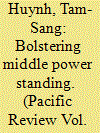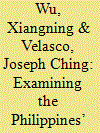|
|
|
Sort Order |
|
|
|
Items / Page
|
|
|
|
|
|
|
| Srl | Item |
| 1 |
ID:
190654


|
|
|
|
|
| Summary/Abstract |
South Korea's reluctant response to the U.S. Free and Open Indo-Pacific (FOIP) strategy so far has failed to send a clear-cut signal to regional countries. Despite upholding multilateralism as the cornerstone of its middle power diplomacy, South Korea has not worked in line with Indo-Pacific second-size powers given Seoul's relatively vague response to the Indo-Pacific structure. With foreign policy shifts from Trump to Biden, South Korea may be well-positioned to communicate its policies with a more nuanced response to the Indo-Pacific. To leverage Seoul's middle power standing and its commitment to multilateralism, the Moon Jae-in administration can be expected to reflect on clearer definitions of what 'Indo-Pacific' means and come up with a more comprehensive understanding of multilateral cooperation in the region so as not to mistake 'Indo-Pacific' for its security connotation. As for South Korea, pursuing a three-headed strategy, for example, continuing to position itself in the Indo-Pacific region as a balancer, enhancing ties with like-minded middle powers, and deepening the South Korea-ASEAN relationship, could accommodate Seoul's interests and concerns amid the U.S.–China strategic competition and the COVID-19 pandemic.
|
|
|
|
|
|
|
|
|
|
|
|
|
|
|
|
| 2 |
ID:
188430


|
|
|
|
|
| Summary/Abstract |
When great powers such as the United States and China grow especially hawkish with more uncertainties, how does a smaller state react to such a complex and dangerous territorial conflict? Given the competing frames of influence between China and the United States, what are the underlying reasons for the shift in the Philippines’ foreign policy? This paper focuses on the Philippines’ changing foreign policy on the South China Sea dispute and examines the main rationale for its shift in strategy towards China. We use the perspective of neoclassical realism to unpack the constraining factors that underlie the Philippines’ domestic politics and ongoing global exigencies. With changes in its domestic politics and the security challenges posed by the evolving geopolitics of the Indo-Pacific region, the Philippines is in a difficult situation, having to choose between a territorially hostile trading partner and its historical security guarantor.
|
|
|
|
|
|
|
|
|
|
|
|
|
|
|
|
| 3 |
ID:
174406


|
|
|
|
|
| Summary/Abstract |
The Trump administration has fleshed out a novel approach called the Indo-Pacific strategy to address the China challenge in the 21st century. Although it is still debatable about the content, aims, and approaches of the US Indo-Pacific strategy, it is crystal clear that China has taken the US Indo-Pacific strategy seriously. Students of international relations have attempted to better understand China's response to the US Indo-Pacific strategy. In this article, I propose a new perspective to comprehend China's strategic and more importantly preemptive response to the US Indo-Pacific strategy, which I call a niche strategy. The niche strategy is a widely discussed marketing strategy in the business and marketing communities. Inspired by the burgeoning marketing studies on niche strategy, this article attempts to conceptualize it in international relations as a vital foreign policy strategy and then to apply it to understand and explain China's strategic response to the US Indo-Pacific strategy. Exemplified and emboldened by the operation of the Asian Infrastructure Investment Bank (AIIB) and the changing orientations of the Belt and Road Initiative (BRI), China's niche strategy can help the country better navigate the pressure from the US Indo-Pacific strategy. However, it still remains a question whether the clash of China's niche strategy and the US Indo-Pacific strategy will lead to war or peace.
|
|
|
|
|
|
|
|
|
|
|
|
|
|
|
|
| 4 |
ID:
174403


|
|
|
|
|
| Summary/Abstract |
The US-China relationship defines geopolitics in the 21st century. Despite a messy start, the Trump administration was able to provide a new national security strategy within the first year in office. The new US national security strategy clearly defines China as a strategic rival that "challenges American power, influence, and interests, attempting to erode American security and prosperity." For the first time, the United States outlined an Indo-Pacific strategy to compete with and contain China's rising power and influence among those countries along the Indian and Pacific oceans. As part of an overall competitive strategy vis-à-vis China, US Secretary of State Mike Pompeo called for "a new alliance of democracies" against China in the international community. The Chinese government has yet to officially respond to the US Indo-Pacific strategy as well as the "free and open Indo-Pacific" concept. Ten years ago, when the Obama administration rolled out the "pivot to Asia" strategy, Beijing's answer was a grand geoeconomic plan to expand Chinese economic power along the ancient Silk Roads on land and sea. Ten years later, how will Beijing respond to the new strategic challenge from Washington? In this article, the authors argue that Beijing has not taken tit-for-tat action to respond to the US Indo-Pacific Strategy. Instead, China has responded to the new American challenge in a more constructive, peaceful, and nonconfrontational manner. Beijing's objective is to mitigate possible national security risks while continuing to extend its international influence in the Indo-Pacific region and beyond.
|
|
|
|
|
|
|
|
|
|
|
|
|
|
|
|
|
|
|
|
|